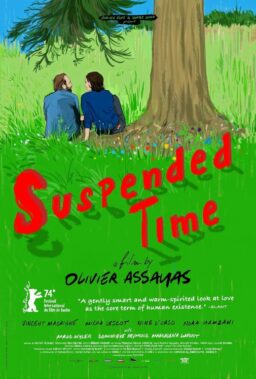 When David Fincher’s “Zodiac” (2007) was released in South Korean theaters, it was immediately compared to a famous South Korean film. That movie was also based on the infamous serial killing case still remaining unsolved to this day, and it is also about the desperation, frustration, and obsession of the people who wanted to find the man behind the horrific killings.
When David Fincher’s “Zodiac” (2007) was released in South Korean theaters, it was immediately compared to a famous South Korean film. That movie was also based on the infamous serial killing case still remaining unsolved to this day, and it is also about the desperation, frustration, and obsession of the people who wanted to find the man behind the horrific killings.
“Memories of Murder” is available on Amazon.com. It is available via Netflix, but not Netflix Streaming. This complete film with English subtitles can be downloaded or watched in eight parts here, at Drama Fans.Org.
• Notes:
2003 was a great year for South Korean audiences. Along with “Memories of Murder”, we had “Oldboy”, an operatic no-holds-barred revenge film by Park Chan-wook, “Spring, Summer, Fall, Winter… and Spring”, a beautiful masterwork by Kim Ki-duk, and that odd cult SF film “Save the Green Planet!” by Jang Joon-hwan. All of them are currently available at Amazon.com.
Bong Joon-ho is currently working on his new movie “Snowpiecer”, set to be released in the next year. This time, while collaborating with Song Kang-ho again, he is working with actors more familiar to you, including Chris Evans, Jamie Bell, John Hurt, Octavia Spencer, Tilda Swinton, Alison Pill, and Ewen Bremner.
But comparing Bong Joon-ho’s “Memories of Murder” (2003) to “Zodiac” is akin to comparing tangerine to grape fruit. While both share some common elements, they are different from each other in many aspects. While “Zodiac” firmly looks at the Zodiac case itself, “Memories of Murder” uses a fictional story inspired by its serial killing case as the window to the South Korean society during the 1980s, an era when lots of infuriating injustices and accompanying brutal violence took place under the military dictatorship.

Even though I was very young at that time, I remember several things about the Hwaseong serial killing case because it was hot news on TV whenever someone was found murdered. Between 1986 and 1991, 10 women of various ages were savagely raped and murdered in the Hwaseong area in Gyeonggi Province. Around 1.8 million policemen were put into the investigation, and around 3,000 suspects were questioned, but there wasn’t any breakthrough in the investigation even when the last murder happened. The identity of the killer is still a mystery even after more than 20 years and it is only assumed that he is currently dead or imprisoned for another crime. (One guy was actually caught and confessed, but it turned out that he was merely a copycat killer).

Beginning on a peaceful sunny autumn afternoon, hovering above a field filled with the waves of a golden rice paddy ready for the harvest, the movie shows us how this case throws the ominous shadow over a quiet country town. While the children are playing around the field, a tractor comes along the road. They cheerfully follow it, and the guy at the back of tractor responds to these joyful kids in a funny way. The tractor stops at one point, and the farmer shows what he found in the drainage ditch to the guy who comes along with him. There is a dead woman who was bound and then murdered, and it seems her corpse was ditched there several days ago.
For local detective Park Doo-Man (Song Kang-ho), it initially looks like an easy murder case. He gathers possible suspects and questions them as usual, though he does not get any useful clues. Soon, a second victim is found in the same area under similar circumstance. Now it is no more a simple crime case to him and his colleagues, and everyone in the station becomes frantic. In one memorable long-take sequence shot with a deft steady-cam operation and precise comic timing, the camera moves around the crime scene along with Doo-man to show us how inept he and others are for their task. It is absurd and hilarious; there is nobody to prevent the people from ruining the crime scene (we even see the children running freely across it), and even important evidence found on the road is destroyed by negligence no less than two minutes after it is found.
As Doo-man and others search for possible suspects, they find one suitable man. He is a mentally retarded guy well known in the town, and it does not matter to the detectives much whether he is really guilty or not. Their priority is calming down the town and closing the case as soon as possible, so they arrest the poor helpless guy and take him to a drab boiler room used as an interrogation room in the basement of the police station. All they have to do is alternatively intimidating and cajoling him while feeding details into his head before extracting a “full confession.” The South Korean police were one of the swords owned by the military dictatorship during that time, and, if they wanted, it was a piece of cake for them to turn into you a criminal or, even worse, a North Korean spy. If there was a will, there were always many, many ways ready for them and they gladly used them.

The movie finds its black humor in their brutality as well as their ineptness in the investigation. In the case of Doo-man’s hot-tempered bullying partner Cho Young-Koo (Kim Roi-ha), his military boots come first instead of his fists when he confronts the suspect to be interrogated. Not so long after that, he and Doo-man and the suspect happily watch their favorite TV show “The Chief Detective” (it is a sort of South Korean version of “Law & Order”) together while eating Chinese food delivered to them. Later, they take the poor guy to a mountain forest and threaten to bury him alive — they even force him to dig the ground.
The detective Seo Tae-Yoon (Kim Sang-kyeong), an urban cop dispatched to the town from Seoul, is none too pleased with this method. He believes in evidence (“documents never lie”, he says) rather than a forced confession, and he tries to solve the case with several pieces of a puzzle thrown to them. He recognizes patterns in murder cases, and discovers there is another victim. With the small help from a policewoman (Ko Seo-hee), he also gets another crucial clue to the identity of the killer. Somebody requested a specific song on the radio whenever a murder was about to happen. Is it just a coincidence, or the insidious prelude for murder?
Loosely based on Kim Gwang-rim’s stage play “Come to See Me,” the director/co-writer Bong Joon-ho made a superb country thriller depending on mood and atmosphere. With its stunning cinematography, its scenes are filled with a unique feeling of the specific time and place, along with the subtle sense of uneasiness. I could appreciate the painstaking details on the screen while being immersed into its world. When I revisited the movie recently, I noticed a small can of ointment, and it was the same brand my mother and others used when I got hurt. And I can assure you that the car named “Maepsy” was actually produced during that time. (If my guess is correct, it means “stylishness” in Korean, by the way).

The movie gives us one of the most vivid recreations of a South Korean country town during the 1980s. If you want to know what I witnessed in my grandmother’s hometown during my childhood, this film can be a good guide for you. Although my grandmother’s hometown is in a different area (it is the Jeong-eup area in Jeonla province, far south to the Hawseong area), the town is also located near a wide field area covered with rice paddies. Her neighbours had houses similar to the ones shown in the movie, and I recognized the same of kind of alleys and fences during one chase sequence. The movie was actually shot in various locations here and there in South Korea, but you can believe that everything in the film happens around one town.
With this wonderfully recreated background, the movie plays us like piano in its slow but steady pace. While there is offbeat comedy generated from its colorful characters, it is also a dark thriller revolving around the terrible incidents. You are amused for a while, and then you realize that something horrific can happen. A small unidentified figure merely rising from the rice paddy and then slowly disappearing below at the corner of the screen is frightening enough to chill your spine. Even when you are sure something will happen, the movie slaps you with a devastating surprise. The murders keep happening, and the autopsy scenes reveal the more twisted side of the killer, who starts doing vile things to the victims’ bodies as if he were mocking the cops chasing after him.
The center of the story is the dynamic relationship between two contrasting cops who eventually find a common ground in their investigation. Their respective methods clash with each other a lot at first, and they naturally do not like each other much, but they are gradually linked by their mutual obsession about the case. Both want to catch the killer desperately, but they find themselves inhibited by the limits put upon them as well as their own limits. They have never encountered such a case like that before, and there is not enough evidence to help their investigation. DNA analysis of a semen sample luckily found in one crime scene was surely possible in the 1980s, so it can be a strong evidence to identify the killer, but the equipment is not available inside South Korea — they have to wait until the analysis result is delivered from US.

They are also frustrated by the system they belong to, and the movie slyly throws in critical comment on the South Korean society during the 1980s. When they urgently call for the additional forces for preventing another murder about to happen, headquarters replies that they are not available because they are all busy suppressing a big student demonstration protesting against the dictatorship in the nearby city. In one sad, emotionally-shattering scene, we see the town going through a routine civil defense drill. The people go inside and close the doors and turn off the light. The town becomes completely silent. And another tragedy is going to happen nearby. Behind the restrained handling of this terrible moment, you can feel the quiet, sorrowful anger toward the society which has frequently failed to protect its individuals while only caring about maintaining and protecting itself. This tendency has not yet gone away even in these days; South Korean people were recently shocked by the news about policemen casually ignoring the desperate call from a woman in danger, who was later found brutally murdered. (At least, the murderer was arrested in this case).
The movie has a terrific ensemble. Even though you are not familiar with most of the performers, their characters are not easy to forget. While we are watching their struggle closely and intimately, the detectives in the film are revealed as the characters free from expected conventions thanks to the lively performances from the main actors. Song Kang-ho, who had just established himself as one of the leading South Korean actors around that time through several notable films including Park Chan-wook’s “Sympathy for Mr. Vengeance”(2002), plays Doo-man as a plain country guy tasked with the job way over his head. Doo-man is certainly not the brightest bulb in his station, but there are times when his eyes and instinct work, especially when he and others have to find a runaway suspect among the men wearing the same work uniform at the quarry. Song Kang-ho always has a likable presence in his films while never reaching for the effect, and that quality works well in the film; you may not like what Doo-man does for extracting confessions, but you cannot help but like this carefree guy who begins to realize what kind of labyrinth he is put into.
While Song’s easy-going performance holds the ground in the middle, his co-actor Kim Sang-Kyeong’s performance effectively swings from one side to the other as a cop who is more reasonable than his peers but becomes slowly unhinged by frustration and helplessness. As Man-soo’s volatile partner, Cho Yong-koo is pretty repulsive at times, but you feel a little sorry for him while appreciating some kind of poetic/karmic justice done to him in the end. Byeon Hee-bong is their ineffectual chief, Song Jae-ho is a sterner successor who also equally struggles with the case, and Ko Seo-hee is a policewoman whose intelligence deserves better than the way she is regarded by male cops.

The other supporting performers are believable as country people living during the 1980s, but special mention must go the three actors who play the prime suspects. As a mentally retarded character who turns out to be more crucial in the case, Park No-sik steals the show while evoking both pity and impatience from the audiences. Ryoo Tae-ho, who originally played all of three suspects in the stage play, is impressive as the second suspect with an understandable private perversion. The wild card of the film is Park Hae-ill, who gives a good “closed book” performance as a suspicious young man. All the circumstantial evidence points toward him — but is it possible that he is just a defiant young man uncooperative with an intimidating cop?
Though it was only his second work, “Memories of Murder” quickly put the director Bong Joon-ho in the list of the prominent South Korean filmmakers. The movie shows his talent in full command. The scenes are carefully planned and executed, and the storytelling is masterful in tuning the ratio of humor and suspense to engage us. Bong has made four films so far, and all of them are interesting works. His first movie, “Barking Dogs Never Bite” (2000), is a quirky black comedy which will make some dog owners cringe as much as, say, “A Fish Called Wanda” (1988). “The Host”(2006) is not your typical monster movie but an eclectic cross between B-monster movies and a dysfunctional family drama seasoned with sly political commentary. His latest work, “Mother” (2009) is another country thriller reminding us that there is still a dark corner in police stations where unpleasant things can happen.

Though it is freer than “Zodiac” because it is a fictional story with a real-life background, “Memories of Murder” finds its own satisfying way of finishing its story while being true to the case left unclosed. There is a “climax” scene, which is neither a resolution nor a conclusion. The characters have to recognize what cannot be changed, and another moment of frustration resonates in the darkness in front of them while one possible lead is walking away from them.

And then the movie moves to a seemingly unnecessary epilogue sequence which turns out to be one of the most haunting closing scenes in my memory. Time has passed, Hwaseong is more urbanized than before as one of the satellite cities surrounding Seoul, and one character coincidentally comes across one of the places in his memory. It feels sentimental at first, but, in the end, he and we are chillingly reminded that the memories of murder never leave him and others. And neither do the memories of that violent era.










